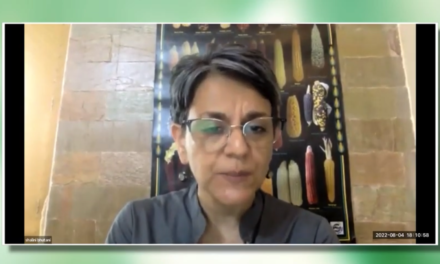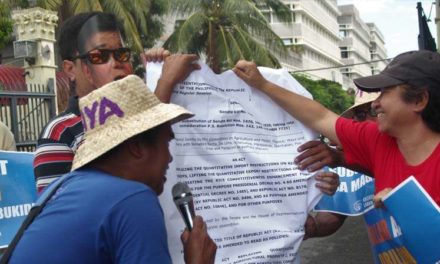by Nicola Bullard*
Apart from the brouhaha of the annual leaders’ summit one of the year’s best photo opportunities APEC rarely gets a mention in the economic pages, let alone the headlines.
But although APEC may be out of sight, it should not be out of mind. Throughout the year bureaucrats, expert committees, advisers and senior ministers toil away from the spotlight shaping policy advice, agreements and ministerial statements on issues such as the pace of trade liberalisation, foreign investment regulations, environmental standards, and dispute procedures. These are matters of importance, and we need to pay attention to what APEC is doing on our behalf, even if it is in our absence.
Take for example the meeting of finance ministers held this April in Cebu and enthusiastically opened by Philippines’ President Ramos who declared that ˜continued rapid development of the region required freer movement of capital, the development of domestic capital markets and the increased private provision of infrastructure’.
The meeting closed on a more restrained note, with the finance ministers adopting a set of voluntary guidelines to ˜ease capital flows and sustain the region’s economic growth’ which are extremely vague and peppered with provisos such as ˜with due respect for our diversity and different levels of development’. The guarded tone is significant, indicating only modest enthusiasm for a free-for-all approach to capital flows and foreign investment and no doubt reflecting the lessons (hopefully) learned from Thailand’s recent tribulations resulting, at least partly, from uncontrolled capital flows. Significant, also, is the ministers’ commitment to support the resumption of talks to achieve a WTO financial services agreement.
Meanwhile in Paris, the world’s 29 wealthiest countries (the OECD) are negotiating their own Mulitilateral Agreement on Investment (MAI). The MAI is due to be concluded in May 1998, and will establish a new international standard for investment regulations. It aims to ease the movement of capital across international borders by limiting the power of governments to restrict and regulate foreign investment. In effect, this could mean almost complete deregulation of investment. Once this standard is adopted it could prove to be an irresistible blueprint for the WTO financial services agreement. If this happens, the sensitivities and national concerns so carefully accommodated in the Cebu voluntary agreement will get crushed in the rush for a binding WTO agreement. However, APEC ministers cannot complain if the pace is forced, after all, they endorsed the resumption of talks at the WTO.
One month later, in May, APEC trade ministers met in Montreal to review progress in trade liberalisation. Again, the final agreements are vague and non-binding with a commitment to consider proposals for ˜sector-by-sector’ liberalisation at the November APEC Summit in Vancouver. And again there is a commitment to ˜defining how APEC could best continue to support the multilateral trading system under the WTO’.
To see where all this might be leading, it is interesting to recall the fate of the information technology agreement which the US pushed through last year’s APEC Summit. The Manila Declaration called for ˜the conclusion of an information technology agreement by the WTO Ministerial Conference that would substantially eliminate tariffs by the year 2000.’ At the November 1996 WTO conference in Singapore the US, bolstered by the APEC mandate, rammed information technology to the top of the agenda and got what it wanted — an agreement covering 85 per cent of world trade in IT products to reduce tariffs to zero by 2000.
In fact, US trade representative Charlene Barshefsky noted in her press conference after the WTO meeting that ˜Without the support of APEC for such an agreement, there is no way this agreement would have come out of Singapore’.
Springboard to the WTO
The US, continually frustrated with the lack of progress in setting specific targets and reaching firm agreements on trade liberalisation within APEC, has changed its gameplan.
At the May 1997 Montreal Trade Ministers meeting, Trade Representative Barshefsky commented that APEC has decided to play a ˜catalytic’ role where agreements can be negotiated to achieve a ˜critical mass’ which can then move rapidly through the WTO. ˜With APEC pushing, agreements can build momentum faster with fewer countries needing to be consulted’, according to Barshefsky.
This is both disturbing and illuminating.
Disturbing because it highlights the possibility of APEC’s non-binding agreements being pushed through the WTO on the basis of their support in APEC without there being any room for discussion, broad consultation or dissent.
Illuminating, because it shows the US strategy of using APEC as a springboard to get issues onto the WTO agenda. Although its agreements are non-binding, the fact that APEC’s 18 members represent almost half the world’s merchandise trade means that de facto APEC agreements carry weight at the WTO.
Slowly but surely the pieces of the global free trade jigsaw are being put in place. Last week the US unveiled its trade and investment interests in Southern Africa and other regions can expect the same attention once their macro-economic indicators and growth rates reach a respectable level. No doubt the international financial institutions are doing their bit to ensure that this is sooner rather than later.
There can be no illusions about the US trade objectives. The 1997 Trade Policy Agenda notes that ˜President Clinton has designed a fair trade policy that seeks to take advantage of the increasingly global economy in a manner that benefits American workers, American businesses and American families.’
It goes on to say that ˜trade is the tool by which we can project America’s core values globally’ and it seems that every strategy is legitimate in pursuit of these goals.
APEC may be out of the spotlight, but it is still one of the key building blocks for a global free trade regime. Importantly, it is also one of the few forums where ˜diversity and different levels of development’ are recognised and, as such, member states should be wary of their carefully nuanced agreements reflecting that diversity being steamrollered by the WTO.
Equally worrying is the fact that issues which really effect people (as opposed to the politicians) such as the impact of trade liberalisation on agriculture and the environment, barely rate a mention.








